Civil Party Statements on Harms Suffered: Cham and Vietnamese
Today, February 29 2016, three Civil Parties have given their testimonies on harms suffered during the Democratic Kampuchea period in relation to the treatment of the Cham and Vietnamese people. Civil Party Moeu Pov talked about the separation from family and the death of 17 family members, including his father. Man Sles provided testimony about a rebellion in Svay Khleang that took place, he said, because Cham people were killed and their religion suppressed. Lastly, Sieng Chanthay told the Court about the suicide of her father and arrest of her brother. She will continue her statement on harm suffered tomorrow.
Civil Party Moeu Pov
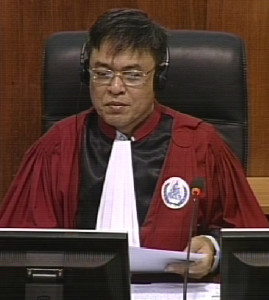
Trial Chamber President Nil Nonn
At the beginning of the session, the Trial Chamber President Nil Nonn announced that the Chamber would hear the statement of harms and suffering by Civil Parties who claimed that they suffered during the Democratic Kampuchea regime in relation to the treatment of the Cham, the Vietnamese, and the former Lon Nol officials. Five Civil Parties would be heard: 2-TCCP-1013, 2-TCCP-263, 1014, 1015 and 2-TCCP-259. 2-TCCP-1013 would start today.
The Trial Chamber Greffier then confirmed the presence of all parties with the exception of Nuon Chea Defense Counsel Victor Koppe, who was absent without reason, and Khieu Samphan Defense Counsel Anta Guissé, who was absent due to personal reasons. Nuon Chea followed the proceedings from the holding cell. The President then ordered to usher in 2-TCCP-1013.
Civil Party Moeu Pov was born in Anteak Kuoy Village, Khmar Commune in Pursat commune on 1 February 1961. He is father of four children. The President inquired whether the Civil Party Lead Co-Lawyers wished to put questions to the Civil Party or whether the Civil Party would make a statement independently.
Civil Party lawyer Lor Chunthy then started putting questions to the Civil Party.
He asked whether he could describe the suffering he received under Democratic Kampuchea regime as a Cham person.
Mr. Pov said that the Khmer Rouge took control of the country in 1975. “They mistreated the Cham people; they forced the Cham people to abandon their religions, their personal property, belonging, and their relatives”. He had been forced to evacuate from his native village. During the Khmer Rouge regime, he was separated from his relatives. There was no proper form of living condition, schooling and religion, he said. “I was at the mercy of Angkar, and they did not provide me any sufficient food.” He had to work day and night, and therefore became “skinny and bony”. When not being able to finish the work schedule, he would be deprived of his already small portion of gruel. “Life was so miserable.” He was between 13 and 14 years old. “And I had to live under a tree without proper accommodation.” “Sometimes I suffered from rain and mosquito bites.”
Separation
Mr. Chunthy asked how he was separated from his family members. He responded that they were separated to work “whatever was ordered by Angkar”. They were forced not to use their Cham language anymore. If anyone did so, Angkar “would take that person away and execute him or her”, which terrified them. He said: “We had nothing to hang onto during the regime.”
Mr. Chunthy then wanted to know whether the prohibition of religion was formerly imposed. He answered that the cooperative made an announcement in 1975 for the Cham people to cut their hair and not to use scarves to cover their hair anymore. They were evacuated from one village to another or one cooperative to another. This was when he lost contact with his family members.
The announcement was made in Anteak Kuoy. His family was evacuated to Tram Sre cooperative. He remained there for only a few days before being sent to the canal and the dams.
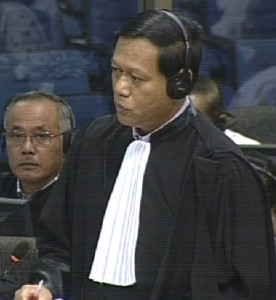
Civil Party Lawyer Lor Chunthy
The Khmer Rouge forced the Cham people to eat pork and “do whatever the Khmer people did”. Thus, they “lost our own identity, our religion”. He said that they were “mistreated in every way”. He recounted: “I lost my strength physically and mentally”. The Khmer Rouge pointed a gun at him, accusing him of betraying Angkar when he stole rice. “They beat me up freely without mercy.” His hands were tied behind his back and he was pulled behind a horse. If he could not catch up with the horse, he was beaten. He was forced to work really hard. If any worker fell to the ground, “that person would be beaten up”. They were not allowed to speak to each other. “I was one of the many prisoners living in the area”. “They also killed people in front of us” to intimidate them. “And that scared me mentally.” He further recounted that he was “only thinking of the day that my term would come”. He never heard anything from his parents during the Khmer Rouge, except that his father died due to a lack of food. “I did not see him during his last break.” He himself was forced to eat pork.
Mr. Chunthy then wanted to know how many family members he lost during the regime. Mr. Pov replied that he lost many family members, including his father, totaling 17 all together. He also lost is nieces and nephews during the period. “And that gave me much pain, and the pain and suffering stayed with me during the present time.”
Death of his father
Asked about the death of his father, Mr. Pov recounted that his father died because he was a Cham person who adhered to his religious practices and did not abandon them, when he forced to do so. He refused to eat pork. “So Angkar gave him a last warning that he had to eat pork”, and if he refused to do so, he would receive no food whatsoever. His father only drank water and ate tree leaves in the forest. “Living in such a situation, I would think that it would be better if they were to kill him, and not allow him to suffer such a terrible circumstance.” At this time, his father’s body became emaciated and he died alone. He did not know where his father was buried. He sought permission to go when his father died, but he was scolded that he was not part of the unit that buried his father and his request rejected. He was therefore not allowed to see his dead body.
After his father passed away, no relative held any ceremony for the burial. There was a unit that was responsible for the ceremony. “We were separated from one another. It was misery.”
His uncle was accused that he betrayed Angkar, was arrested, and then killed. “He was chopped into pieces alive, and his body was salted. The child of my granduncle knew about his death. Torture was inflicted on him. He was suffering from a great deal of misery before he died.”
Mr. Chunthy then inquired about the torture that was inflicted upon his granduncle and whether this took place in the same village. Mr. Pov replied that it took place in Traulo village, Bakan District, Pursat Province.
Detention
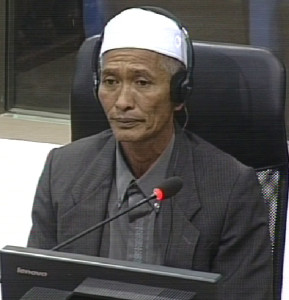
Civil Party Moeu Pov
Next, Mr. Chunthy wanted to know about his detention. Mr. Pov answered that he was detained at Tra Kraol Detention Center, where he witnessed the killing of a woman who was accused of having committed moral offense. “She was asked to take of her clothes and her body was cut open.” He was asked to look at the killing of the woman. He could not see whether the woman was pregnant, but “there was blood everywhere after her body was cut open. The liver was taken out of the body and that liver was cooked for meal. I was so scared at the time, since I was a young boy, so I had to abandon everything. Even my name, I did not use my name Mahamad, but instead I used Moeu Pov.” If they knew that he was a Cham person, he would be in a difficult situation. “I had to do everything for the sake of my life.” He was chained during day time and shackled at night time as well. “I was so young at the time, so I could not catch up with the others for walking, and I was used as an animal.”
He said that “the killing was based on no reason”. If they had cried at the time, they would have been killed. “Every time that there was a killing, all of us were called to the execution place to witness the incident.” The Khmer Rouge did not care about their young age. When the shackles were taken off their ankles, they were forced to work. They had to sleep on the ground and were not allowed to talk to each other. There were around 40 people in the detention facility.
Mr. Chunthy asked where the “misery” happened and what year. Mr. Pov said that in late 1977 and early 1978 he was arrested and placed into Tra Kraol Detention Center.
During the day time, he was released to go to work and the chain was locked to their ankles and linked to each other. While he was working, he was chained to other people. He was arrested in Trang cooperative, and detained around ten kilometers away from his cooperative. For food, they received one ladle of watery porridge. “If one dared to say that they did not have enough food to eat, they would be accused of betraying Angkar.”
Education
Mr. Chunthy then inquired about education. He answered that there were no schools and professors, since the schools were shut down at the time. “We suffered from miserable life and I, at the time, imagined that others were wearing nice clothes, short trousers and white shirts”. He had to do hard labor and was skinny. He did not have time to “take a rest” during the day time and could not sleep well at night. He pitied his family at the time, who had suffered as well. As for education, “it happened to our family and in particular the whole society, we received no education, so because of this, it affected my family and the whole society after 1979.” He regretted that he had not received any information, and “it had great impact on my livelihood.”
He could not recall who made the announcement for the evacuation and the separation of his family, but he was told that it was made in a meeting by the chief of the cooperative. “We had to be on our own with nothing”. Because of this regime, “I inherited nothing of my parents.” His family was seen as a capitalist family and Cham people. “We were dispersed from being in one group.” If the Khmer Rouge had known that “we had many cattle and personal belongings, those belongings and properties had to be appropriated.”
His family was put in a group below the 17 April People group. “We were put to live under the surveillance. We were considered feudalists and capitalists. I did not know what that meant at the time, since I was a young boy.” What he knew was that his family members were forcibly transferred from his native village to an area where there were no Cham people.
When war erupted, they went to live in a village with the Cham people and evaded from the locations where there were bombings and shelling. From this location, they could practice their religion and speak their language. They had to leave their native villages. They were told to leave for different locations. Women were told to have their hair cut short and live in a “normal way” as Khmer people. Those who did not abandon their religion would be killed.
Mr. Chunthy then wanted to know whether all Cham people were told to live in different places or in one place when they were evacuated. He said that they were not allowed to live in “one same place”. His family lived in a different location from others. Some people were put in mobile groups. “No one could live and reside in the same location”, he said. Turning to his last line of questioning, Mr. Chunthy inquired what suffering had made a lasting impact and was unforgettable. Mr. Pov answered that the education that he never had had did have a lasting impact, as well as the property that he should have inherited. “This kind of suffering is like a shadow following me every day. I regret that I have had no education. Secondly, I was detained in a prison where people were killed in front of me. Every time I close my eye, I recall those past experiences. I am so terrified as of now when recalling those kind of incidents.” As for Cham language, he could speak better Khmer than Cham for everyday conversations.
Executions and dead bodies
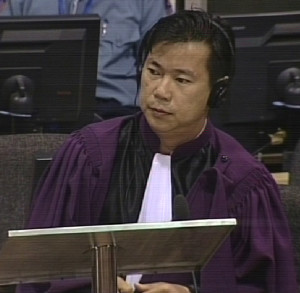
National Deputy Co-Prosecutor Srea Rattanak
The floor was then granted to the Co-Prosecutors. National Deputy Co-Prosecutor Srea Rattanak asked which year he was evacuated. Mr. Pov answered that on 17 April 1975, he was evacuated from his village to live in Tram Sre Cooperative. In late 1975, his family was evacuated to live in Mes Tok Cooperative. Tram Sre Cooperative was located in Chhmar Commune in Bakan District, Pursat Province. He did not know what the commune was called during the Khmer Rouge regime.
He used to see dead bodies, but he did not know who executed them for what reasons. In Tram Sre Cooperative, he only knew that an entire Cham family, who came from other locations, possibly from Phnom Penh, was killed. He saw dead bodies in a rice field.
Mr. Rattanak then referred to his OCIJ interview, in which he had said that he saw the Khmer Rouge killing people.[1] Mr. Rattanak asked to clarify the matter, since he had said that he did not witness the killing just now. Mr. Pov answered that regarding this one Muslim family, he did not witness the execution, but he did witness the killing of other people. Mr. Rattanak wanted to know whether it was therefore correct that he briefly witnessed another killing at another occasion. At this point, National Counsel for Nuon Chea Liv Sovanna objected to the question and said that the Civil Party had already said that he had not witnessed the killing. Mr. Rattanak rephrased his question and asked whether it was correct that he saw dead bodies from Kilometer Number 9 and saw another killing at some other point. He answered that the first family was taken away and killed. He saw another Muslim family being killed. He did not see the killing clearly, but saw the attire worn by the Khmer Rouge. He saw this at Tuol Sleng and another killing at a rice field near that Tuol Sleng. He incidentally witnessed the killing at Tuol Sleng, but did not remain long, since he was afraid the Khmer Rouge militia would see him and accuse him of being a traitor.
At this time, the President adjourned the hearing for a break.
After the break, the floor was again granted to the Co-Prosecutors. Mr. Rattanak asked where Tuol Sleng was. He answered that it was in Khmar Commune in Pursat Province. The incident he witnessed took place in the forest around 3 pm. It was around fifty meters away. He did not “see things clearly”, because the area was a forest. He saw that the militiamen were executing the people. They used a stick to kill the people, but he did not know whether the club was made out of bamboo or another wood. He did not know who the executioners were, aside from that they were Khmer Rouge militiamen. He did not know how many militiamen there were. He did not hear the voice, “because I was there for so short”. He did not know how many victims there were. When witnessing the event, there were more than five people. He knew that they were Muslim, because he identified them through their clothes. He saw their bags of clothes, which is why he came to the conclusion that they were Muslim.
As for the dead bodies that he saw, he said that there were around four or five dead bodies. He did not know how many more dead bodies there were. When the regime “alleged people of betrayal, they killed people” and left them unburied. He saw these bodies near Tuol Sleng, where the execution of people took place. There was a paddy field nearby.
Moving to his next topic, Mr. Rattanak asked what he knew about “something that happened to Islam religious leaders” and religious scholars. Mr. Pov answered that they were taken away and killed during the Khmer Rouge regime. He did not know where they were detained or killed. He had some relatives who knew a lot about Islam, and who were killed as a result of this.
Mr. Rattanak referred to Mr. Pov’s interview, in which he had said that imam and tuon were killed during the Khmer Rouge.[2] Mr. Rattanak wanted to know where his relative was killed. He answered that it took place in Damrei Sor. The imam was responsible for leading the prayers in the mosque, while the tuons were teachers. He did not witness how these people were killed, but heard it from other people. Some of his 17 relatives that died during the Khmer Rouge were imam and tuon.
Mr. Rattanak moved to the next line of questioning and inquired about the treatment of former Lon Nol officials. He answered that he was too young to know much about the matter and did not pay much attention either. He denied having had any relationship with Lon Nol soldiers. Mt. Rattanak referred to Mr. Pov’s statement, in which he said that he saw around 30 or 40 dead bodies of Lon Nol soldiers.[3] Mr. Pov said that he recognized the uniforms at Tuol Ta Kotang, but did not see the weapons that were used to kill them. This was in Tram Sre cooperative, Bakan District.
At this point, the President interrupted the questioning and said that he had used all his time.
Separation from parents
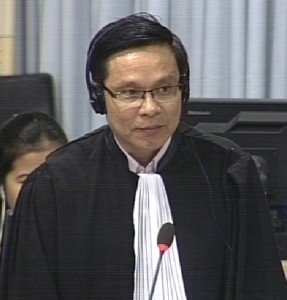
National Nuon Chea Defense Counsel Liv Sovanna
The floor was given to the Nuon Chea Defense Team. National Defense Counsel Liv Sovanna asked whether the Khmer children were also separated from their parents. He answered that Khmer children were also separated from their parents. However, the Khmer children were in their children unit together with Khmer children, while he was alone. As a Cham child, he spent time in the children unit, but he was the only one who was Cham. There were many Cham children at the time, but Angkar “did not allow Cham children to stay in the same unit”. They were separated, although there were many of them. He did not know about the Khmer Rouge structure at the time. He rejected Mr. Sovanna’s conclusion that he was the only Cham person in the unit, because he was the only Cham in the cooperative. He was the only Cham child in the unit, but did not know how many Cham children were living in the area.
He was born in 1961, which made him 13 to 14 years old at the time, he said. Before the Khmer Rouge took power, he went to school to Grade 1. He was in Grade 1, because of the lack of schools and because he had to tend the family’s cattle. He did not study between 1972 and 1975, because of the war.
The neighboring Khmer families were there, while they were regarded as the 17 April People. Some Khmer people were appointed to be in charge of 17 April People.
Mr. Sovanna asked whether it was correct that his father was not taken away and killed, although he refused to eat pork. Mr. Pov replied that Angkar mistreated and tortured him in the way. It was also a form of killing, Mr. Pov submitted, even if they did not put an immediate end to his life. He had seen the dead bodies, after which children ran towards him and told him that the Muslim family had been taken away. He noticed their identity when there were bags of clothes scattered in the area, which included sarongs. He could not recall the month or year when this took place. He said he saw dead bodies in 1975. They were not wearing traditional attires, but he saw traditional attires in the area. After they died, he saw the clothing they wore – they were not traditional attires. These traditional attires were in the bags that were scattered in the area.
Mr. Sovanna turned to the next group of people he claimed to have seen being executed and asked whether those people were Khmer or Cham. Mr. Pov answered that they were a group of Cham people, but did not see the whole execution. He knew they were Cham from the scattered objects and clothing. They were killed in 1975 and therefore the first group who was killed. Thus, he drew the conclusion that the scattered clothing belonged to them.
As for the detention, he said that he was detained at Tra Kraol in late 1977 or early 1978. The militia accused him of committing something against Angkar – that is that he stole rice grains from Angkar. In 1979, villagers came to liberate him. He was imprisoned from 1978 until early 1979.
Mr. Sovanna said that he told the court that he was arrested in October 1978 and that he was arrested, because he failed to report those who stole the rice grains.[4] He answered that he saw people stealing rice grains in October 1977. He said he was accused of having failed to report the betrayals of Angkar.
Mr. Sovanna moved on and asked whether his four siblings survived Democratic Kampuchea. He lost only his father and his siblings survived. Some of his 17 family members who died, died out of starvation, malaria and some were killed.
Back to the Security Center
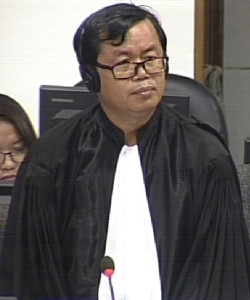
National Khieu Samphan Defense Counsel Kong Sam Onn
The floor was then given to the Defense Counsel for Khieu Samphan. National Defense Counsel Kong Sam Onn asked where exactly the security center was located. Mr. Pov answered that it was located in the area that he could not recall, since it was located in a village and not a pagoda. He knew it was in Bakang District, Pursat Province. He knew it was a security center, since the area was “strictly guarded” and it was the area that he was detained. Mr. Sam Onn asked whether he was aware that Tra Kraol was part of the Closing Order in Case 002/02. Mr. Pich Ang objected to the question and said that the Civil Party was not aware of the proceedings and scope of the trial. Mr. Sam Onn said that as a Civil Party, he was part of the case. The objection was overruled. Mr. Pov replied that he did not know about this.
Mr. Sam Onn asked what his reaction was to the fact that Tra Kraol was not mentioned. He answered that people acknowledged that this detention center existed and that he therefore did not know what he should say. Mr. Sam Onn asked for a reaction to the fact that it was beyond the scope of the trial. His experience at Tra Kraol was therefore not part of the trial. The President interjected and said that Mr. Sam Onn should have objected at the beginning of the statement on harm and suffering, and he should put factual questions, since the question Mr. Sam Onn had posed was very legal. With this, Mr. Sam Onn finished his line of questioning.
The President then said that the Civil Party was allowed to put questions to the accused through the Chamber.
Mr. Pov addressed the Chamber:
Mr. President, I have two questions. I’d like to ask the accused the following questions: one, why the accused mistreated the Cham people so terribly. And why did they force the closure of the religious practice?
The President informed the Civil Party that the accused exercised their right to remain silent and maintained their position until now. He thanked the Civil Party and dismissed him The President then adjourned the hearing for a break.
Civil Party Man Sles
After the break, the President ordered to usher in the next Civil Party. Man Sles was born in 1945 and lives in Village 5, Svay Khleang Commune, Krouch Chhmar District, Kampong Cham Province. He is retired and has two children with his current wife.
The floor was then given to Civil Party Lead Co-Lawyers. Civil Party lawyer Kim Mengkhy started his line of questioning by asking whether he could provide his testimony albeit having abdominal pain. He said that “it’s fine”, particularly because he wanted to address the Chamber regarding the suffering inflicted by the Khmer Rouge.
He recounted that the Cham people were
- Ordered to cut their hair short
- Prohibited from praying
- Prohibited from going into their houses to find the Qur’ans
The Khmer Rouge arrested the religious leaders, hakims, hajims and religious teachers, amongst who was his father. The Khmer Rouge arrested his father when he was working on a field and took him away on a horse cart. Later, his family was weeping secretly. His father was sent to the district hall. They have never seen him again. “We miss him so terribly and every time we, the Cham people, are holding the holy ceremony, there is no presence of my father.” During the time that the “youth group banged the drum and water buckets in order to call the Cham people to resist”, they had understood that they had to resist for the survival of their religion. He was engaged in the rebellion and joined with others. Many Cham died and a few Khmer Rouge. The Khmer Rouge were armed better. After one day and one night of rebellion, the Cham people laid down the weapons and “we were defeated.” The Khmer Rouge mobilized all of them into the tobacco kiln. Women and children were put into a pagoda. They were deprived of meals and were allowed only a bowl of watery porridge. While he was detained, “I missed my family members and siblings”. He did not know how much they suffered as much as he did at the time, since they were separated from each other. There was enough space in the tobacco kiln, but there was no sanitation. The place was full of dog excrements. While they were there, their names were registered. “People kept disappearing from time to time and it was lucky for me to survive”. They collected biographies, since they were “trying to search for the ringleaders of the rebellion.” He was worried about his wife, who had just delivered the baby three months before. Five to ten days later, he felt relieved, since he was allowed to meet his family again. His mother and three of his siblings were sent elsewhere. His wife, his infant and himself were very skinny and bony. His infant’s head was bigger than the body. They were then sent to Stung Trong District. When arriving there, Angkar asked them about their background. He answered that he was a fishermen. He would visit his wife once or twice a year. He could only visit them at night time, since his wife had to work. When Mr. Mengkhy asked whether the Civil Party had plans for the future at that time, Mr. Sam Onn objected and said that he did not ask about facts. Mr. Pich Ang replied that the question was appropriate. The objection was overruled.
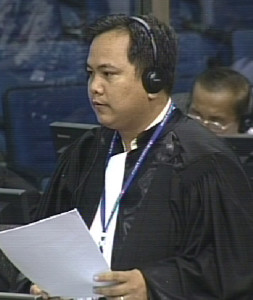
Civil Party Lawyer Kim Mengkhy
The Civil Party replied that he felt he would die. There were four people fishing together. Amongst them, there was one Khmer person who was in charge of the boat. They would go fishing early in the morning. There was no rest during the time, but for night time they had one hour rest. They rested on the boat, before starting to fish again. After having their meal, the “same pattern occurred.” They were given four small fish for the whole group. The fish had the size of a toe. He visited his mother and three younger siblings. However, his siblings were sent to a worksite and his mother was working near the house. He met her for a brief moment, since he was afraid that he would be spotted. On a separate occasion, he was asked to find strings to repair fishing nets. He went back to his mother’s place, but could not find them there. He was told that his mother and three siblings had been taken away and killed. He also lost his father. When returning to his fishing area, he wept quietly. His colleagues asked him what happened, and he lied to them saying that he had abdominal pain. When he first visited his mother, she told him that his younger siblings had been sent to a work site and were so emaciated that he would hardly recognize them if he saw them. When he returned after the second visit and could not find the family, “I wept like a child”. At this point, Mr. Mengkhy handed the floor to Civil Party Lead Co-Lawyer Pich Ang.
Religious traditions
As a Cham person, he prayed five times a day. “We would never miss any occasion”. If they missed a pray time, they could substitute it by another pray time for that particular day. “Otherwise, we would be seen […] as committing a sin.” Due to the abolishment of the religion, the Cham people rebelled, since they respected the religion strictly. Occasionally, he secretly prayed. “Of course I was concerned that I would be tracked or monitored by the Khmer Rouge.” He saw them patrolling on the street, but did not know whether they lay under the house to listen to them. He did not dare to speak their language from that day onwards. The Cham people were prohibited from eating pork, but when they (the Khmer Rouge) cooked food, they put pork with oil in the gruel. They tried to get rid of the soup that had pork in it and only ate rice. Some people could not bear it, while others ate it in order to survive. He was separated from his other family members. He was forced to overwork. He was never allowed to meet his wife during the daytime and could only see his wife every once in a while. The food ration was not sufficient. When the war ended, they returned to their native language. There were several other languages who returned to live in his village. The native villagers who used to live there, only around 50 % of them returned. Other villagers came from others parts to live in Svay Khleang. There were 800-1000 families before the Khmer Rouge.
Mr. Ang then asked a question for his international colleague, namely how long it took them to elect new tuons after the Khmer Rouge. He answered that this happened in 1989 in his village.
The President then handed the floor to the Co-Prosecutors.
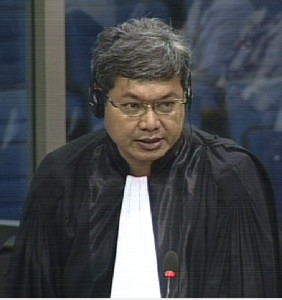
National Civil Party Lead Co-Lawyer Pich Ang
Senior Assistant Prosecutor Travis Farr asked whether there was a mosque in Svay Khleang, and if so, what happened to it during the Khmer Rouge era. Mr. Sles answered that no one went to the mosque to pray, since the Khmer Rouge prevented from doing so. Cattle and tobacco was stored in the mosque.
Turning back to the arrest of his father, Mr. Farr sought more details. Mr. Sles recounted that they came to arrest his father on the corn field behind the house, since they accused him of being an enemy. Other people were arrested together with his father. Around 50 to 60 people were arrested at the time. “Later on, all of them were released, except five – including my father.” They lived in the same village, but he did not know their names. The people who were arrested were Cham, including men, women and children, aged from five years old onwards. There were not many children. The children were aged between five and fifteen. The Khmer Rouge made the arrest. They wore black uniforms and a krama around their neck. The Civil Party was also amongst the fifty people who were arrested. They were arrested, tied up and placed under the house of the Khmer people. They were released around a week later, while five were placed on a horse cart and taken away. His father was amongst these five. His father was the second assistant in the village. Hakim was a chief, then a first deputy and then a second deputy or assistant. When the chief was not available, the first or second deputy would act in place of the religious leader hakim. These five people never returned.
Mr. Farr referred to his Civil Party application, in which he had described arrests.[5] Mr. Sles replied that Ly Minh was working in the village and Kao was a village chief. The district office the five people were taken to belonged to Krouch Chhmar. When his father was arrested, he was tied up and put on a horse cart and had disappeared ever since. The arrests had occurred between 1973 until 1975, at which point there was a rebellion. He did not have an estimate how many people were arrested until the rebellion.
Rebellion in Svay Khleang
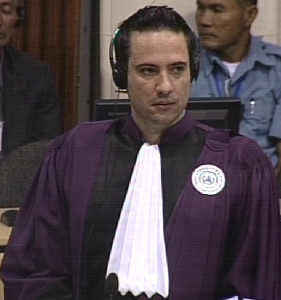
Senior Assistant Prosecutor Travis Farr
After the break, Mr. Farr resumed his line of questioning. When Mr. Farr inquired about the rebellion, Mr. Sam Onn interjected and had a general observation regarding the rebellion and said that the Civil Party had to testify regarding the facts. Mr. Farr repeated his question and asked about the reasons for the rebellion. Mr. Sles answered that the Khmer Rouge had killed many of the Cham people, which was the reason for the rebellion. Soldiers armed with weapons were seen during the rebellion. They were evacuated from their villages to go to a different location. They were placed into a tobacco kiln and the women into a pagoda.
Mr. Farr inquired about the last sentence of his Civil Party application and wanted to know who the two people he mentioned were and whether they were involved in the evacuation of Svay Khleang.[6] He answered that Pheng Heng and Long were working in the village. They were in charge of his village as the village chief (Long) and deputy chief (Pheng Heng).
Turning to his last line of questioning, Mr. Farr inquired whether he could tell him in as much detail what the villagers told him where his mother and siblings were taken and how they were killed. He replied that he talked to the villagers for perhaps two minutes. He was told that his family members were sent to Boeung Keung Chhor to be killed. He said the killing took place in Stung Trong. He did not know the method of killing. With this, Mr. Farr finished his examination.
Reasons for rebellion
The floor was then given to the Defense Team for Nuon Chea. National Defense Counsel Son Arun. He asked whether he knew why the Cham people rebelled against the Khmer Rouge, even though the Khmer Rouge had just won and the Cham did not have any weapons. Why did they rebel against the “hard-won victory of the Khmer Rouge”? Mr. Sles replied that there were two reasons: for one, many Cham had been killed. Second, the Cham were not allowed to practice their religion. Thus, they rebelled against the Khmer Rouge. He was behind the others who were in the front line of the rebellion.
The rebellion was “like a battlefield” in which they were engaged in war. The Khmer Rouge died in a small number. He said that he was of the opinion that he would die even when not rebelling. “Cham people had been arrested to be killed.” He said that “They had to rebel for the sake of our Holy Guard or Allah”. Mr. Arun wanted to know the reason why Khmer Rouge had arrested three, four or five Cham people at night time. He said that he did not know.
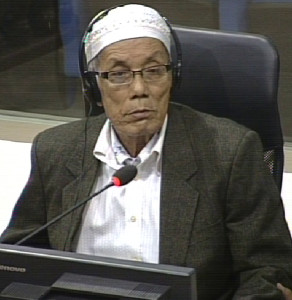
Civil Party Man Sles
Mr. Arun asked why Cham people were not exterminated in Lon Nol regime. He answered that there was no racial discrimination in the previous regime and Cham people were allowed at school. After a brief word exchange with the President about his line of questioning about causes of rebellions, Mr. Arun finished his line of questioning.
The Civil Party was then given opportunity to put questions to the accused through the Chamber:
Question number one: why did Khmer Rouge hate Cham people? Number two: why Khmer Rouge wanted to exterminate Cham people? The third question: in relation to religion of Allah, why did Khmer Rouge consider that Allah religion was a reactionary or feudalist religion?
The President informed the Civil Party that the co-accused exercised their right to remain silent. He thanked the Civil Party and dismissed him. He then ordered to usher in 2-TCCP-1015. The President said that another Civil Party was scheduled first, but due to health reasons, the schedule was adjusted and 2-TCCP-1015 in.
Civil Party Sieng Chanthay
Civil Party Sieng Chanthay was born on 15 April 1962 and lives in Svay Rieng Commune in Svay Rien Province. She is divorced and has one son. The Chamber then gave the floor to the International Civil Party Lead Co-Lawyer Marie Guiraud. She said that he had indicated in his Civil Party application that her father’s suicide had a lasting psychological impact on her.[7] She recounted that her father was Vietnamese and her ancestors were Vietnamese people living in Cambodia. The Khmer Rouge evacuated them to their home town. There, they were seen as 17 April People. They were accused of being feudalists and capitalists. After travelling for around ten or 20 days, his brother – a soldier – was also evacuated from Phnom Penh and was sent to attend the study sessions. Her brother was released after six months, but was arrested later. She did not dare to tell her mother, since she was sick. Someone stole chicken around half a month later. That person was taken away and mistreated. The Khmer Rouge kept beating her elder brother. She was following the elder brother. The Vietnamese troops withdrew, because they were not strong.
They were sent to a cooperative and sent into the Special Force group. They had to return back to their shelter at night time. She did not see her brother during day time, and was prevented from asking about him. When returning home, her brother was taken away in reply. He was sent to carry belongings of the militiamen. Four people had been arrested. She could not speak anymore and wept. Two daughters of Vietnamese families were raped. Her father was terrified. After hearing this, she did not want to live anymore. She did not want “those people to take me away”. She was afraid of being mistreated as well. She wanted to commit suicide. Her siblings told her not to commit suicide. Her father also wanted to commit suicide. “He wanted to hang himself with the krama.” Her mother tried to convince her father not to commit suicide. She pleaded her father not to leave them behind. He told her that she should take care of her younger siblings.
In the morning around 8 am, his mother “and all of us” looked at the Preang Khlang Tree. Her mother realized that her husband hang there. Villagers told them to cut off the bench of the tree so that the body could be taken down. Her mother told them to take the body very slowly down from the tree. After the krama was untied and her father’s body taken to the ground, the Khmer Rouge told them to drag the body on the ground. Every villager knew that the father committed suicide, “because he wanted all of us to survive”. After this, the coffin was made from the sugar palm leaves to cover him. The leaves were not long enough, so his legs were seen.
A few months later, she was walking on the embankment to her work. Her elder brother was walking with the group of educated people. He called her and asked her whether she had tobacco. Her mother knew that her brother was working close to the field where they were working, so her mother wrapped some tobacco to drop it off there. He thought rice was wrapped and given to him, but her mother did not dare to do so.
“Sometimes, I do not feel well.” Her mother drank water and almost died from choking it. Her mother also wanted to commit suicide after her father died, but the Civil Party pleaded her not to. Her mother cried “too much there were no tears in her eyes left anymore”.
After she returned from harvesting rice, she met her younger sibling. When trying to speak to her, her sibling did not answer. When returning home, her mother told her to ask for rice. As she reached the kitchen hall, everyone was staring at her. She thought they would shoot her. A little later, she was told her father had died. Her mother kept weeping. It was night time. A secret lighter was handed to her to light the lamps so that the house was lightened. This secret lighter was used by her father on a daily basis. After having been handed this lighter, she released she had no father anymore. “I was talking to myself that I was half-blooded Vietnamese”. She did not know when it would be her time to be taken away.
One day, a co-worker told her that his or her parents did not want this person to talk to her, since she was half-blooded Vietnamese. She could not speak Vietnamese. She missed her elder brother a lot, “who was tortured” and her father. When someone is beaten today, she does not dare to look at it, because this reminds her of her father and brother. “This feeling is haunting me.”
At this point, the President adjourned the hearing. It will resume tomorrow, February 29 2016, at 9 am. Ms. Chanthay’s testimony will continue, after which 2-TCCP-1014 will be heard.
[1] E319/13.3.4, at answers 24 to 30.
[2] E319/13.2.4.
[3] E319/13.2.4 at question 40.
[4] D22/1078, at p. 5, no translation available.
[5] E3/6714, at 01089920 (EN), 00563975-75 (KH), 01137854 (FR).
[6] E3&6714, last sentence.
[7] D22/366.
Featured Image: Civil Party Sieng Chanthay (ECCC: Flickr)
